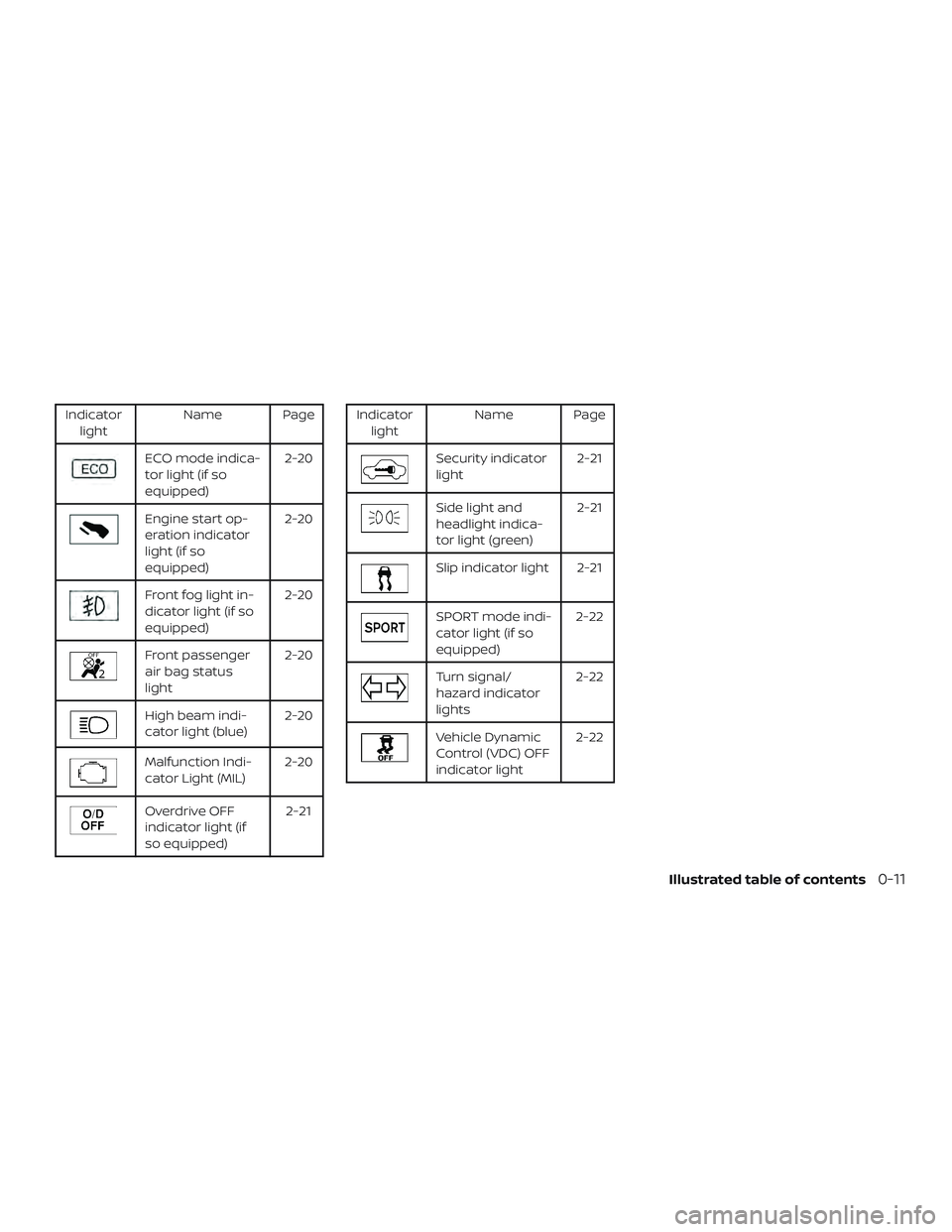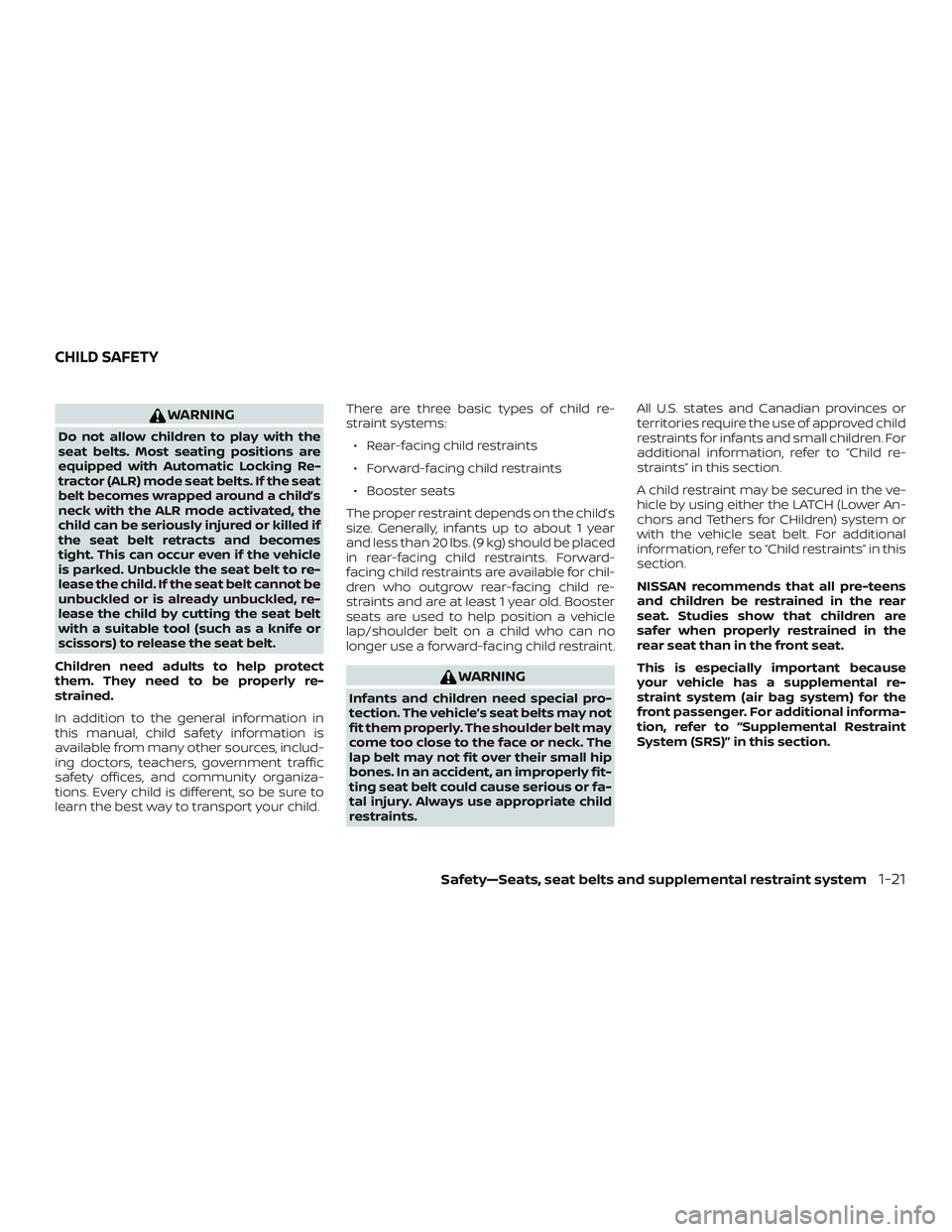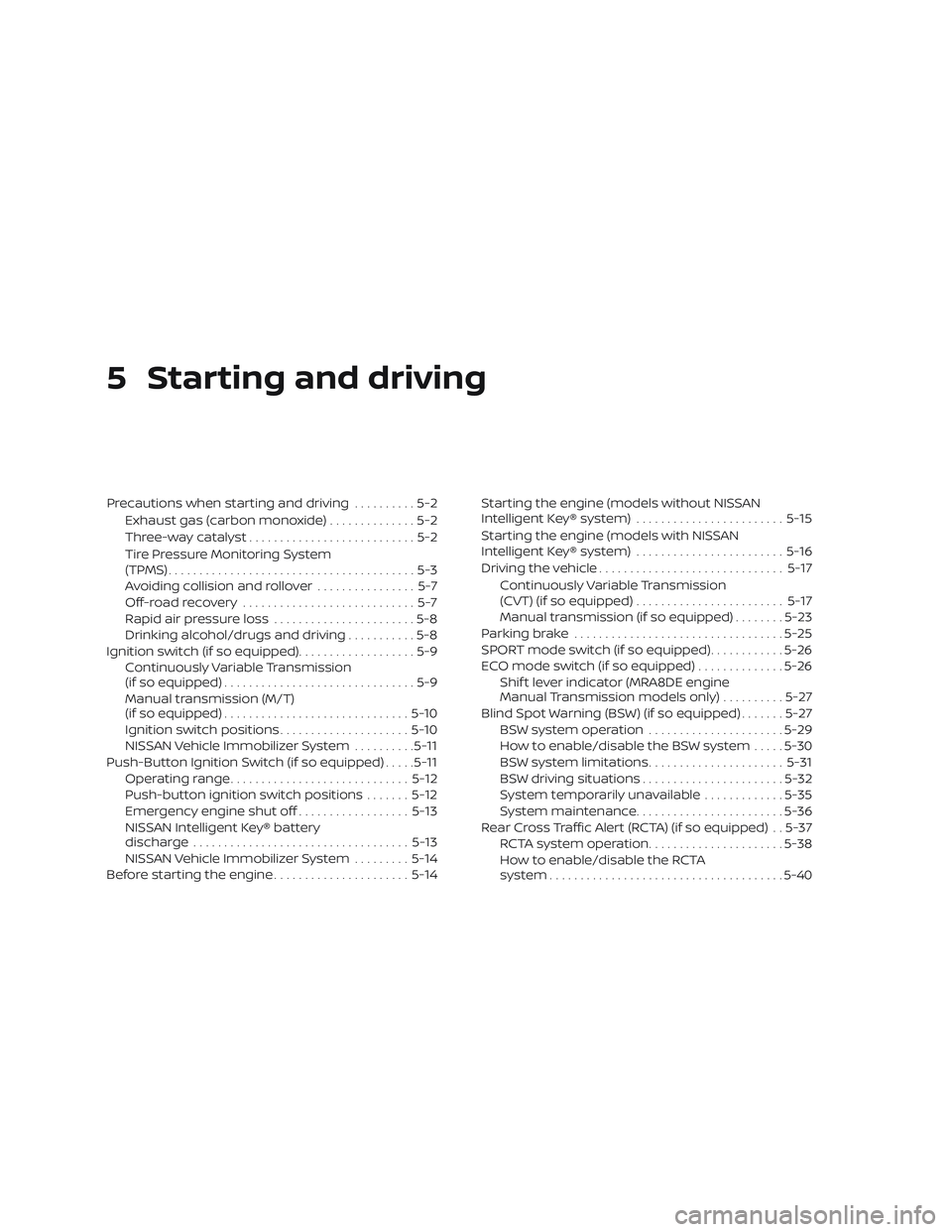2018 NISSAN SENTRA sport mode
[x] Cancel search: sport modePage 25 of 507

11. Front passenger supplemental airbag (P. 1-44)
12. Glove box (P. 2-50)
13. Shif t lever (P. 5-17)
14. Climate controls (P. 4-23, 4-31)
15. Ignition switch (if so equipped)
(P. 5-9)
Push-button ignition switch
(if so equipped) (P. 5-11)
16. Tilt/Telescopic steering (P. 3-30)
17. Hood release (P. 3-25) Fuel filler door release (P. 3-27)
18. ECO mode switch (if so equipped)
(P. 5-26)
Vehicle Dynamic Control (VDC) OFF
switch (P. 2-48)
SPORT mode switch
(if so equipped) (P. 5-26)
19. Instrument brightness control
(P. 2-41)
Power mirror switch (P. 3-32)
Trunk release (P. 3-26)
* Refer to the separate NissanConnect®
Owner’s Manual (if so equipped).
Refer to the page number indicated in
parentheses for operating details.
Illustrated table of contents0-7
Page 29 of 507

Indicatorlight Name Page
ECO mode indica-
tor light (if so
equipped) 2-20
Engine start op-
eration indicator
light (if so
equipped)2-20
Front fog light in-
dicator light (if so
equipped)
2-20
Front passenger
air bag status
light2-20
High beam indi-
cator light (blue)
2-20
Malfunction Indi-
cator Light (MIL)2-20
Overdrive OFF
indicator light (if
so equipped) 2-21
Indicator
light Name Page
Security indicator
light 2-21
Side light and
headlight indica-
tor light (green)2-21
Slip indicator light 2-21
SPORT mode indi-
cator light (if so
equipped)2-22
Turn signal/
hazard indicator
lights2-22
Vehicle Dynamic
Control (VDC) OFF
indicator light2-22
Illustrated table of contents0-11
Page 51 of 507

WARNING
Do not allow children to play with the
seat belts. Most seating positions are
equipped with Automatic Locking Re-
tractor (ALR) mode seat belts. If the seat
belt becomes wrapped around a child’s
neck with the ALR mode activated, the
child can be seriously injured or killed if
the seat belt retracts and becomes
tight. This can occur even if the vehicle
is parked. Unbuckle the seat belt to re-
lease the child. If the seat belt cannot be
unbuckled or is already unbuckled, re-
lease the child by cutting the seat belt
with a suitable tool (such as a knife or
scissors) to release the seat belt.
Children need adults to help protect
them. They need to be properly re-
strained.
In addition to the general information in
this manual, child safety information is
available from many other sources, includ-
ing doctors, teachers, government traffic
safety offices, and community organiza-
tions. Every child is different, so be sure to
learn the best way to transport your child. There are three basic types of child re-
straint systems:
∙ Rear-facing child restraints
∙ Forward-facing child restraints
∙ Booster seats
The proper restraint depends on the child’s
size. Generally, infants up to about 1 year
and less than 20 lbs. (9 kg) should be placed
in rear-facing child restraints. Forward-
facing child restraints are available for chil-
dren who outgrow rear-facing child re-
straints and are at least 1 year old. Booster
seats are used to help position a vehicle
lap/shoulder belt on a child who can no
longer use a forward-facing child restraint.
WARNING
Infants and children need special pro-
tection. The vehicle’s seat belts may not
fit them properly. The shoulder belt may
come too close to the face or neck. The
lap belt may not fit over their small hip
bones. In an accident, an improperly fit-
ting seat belt could cause serious or fa-
tal injury. Always use appropriate child
restraints. All U.S. states and Canadian provinces or
territories require the use of approved child
restraints for infants and small children. For
additional information, refer to “Child re-
straints” in this section.
A child restraint may be secured in the ve-
hicle by using either the LATCH (Lower An-
chors and Tethers for CHildren) system or
with the vehicle seat belt. For additional
information, refer to “Child restraints” in this
section.
NISSAN recommends that all pre-teens
and children be restrained in the rear
seat. Studies show that children are
safer when properly restrained in the
rear seat than in the front seat.
This is especially important because
your vehicle has a supplemental re-
straint system (air bag system) for the
front passenger. For additional informa-
tion, refer to “Supplemental Restraint
System (SRS)” in this section.
CHILD SAFETY
Safety—Seats, seat belts and supplemental restraint system1-21
Page 99 of 507

11. Front passenger supplemental airbag (P. 1-44)
12. Glove box (P. 2-50)
13. Shif t lever (P. 5-17)
14. Climate controls (P. 4-23, 4-31)
15. Ignition switch (if so equipped)
(P. 5-9)
Push-button ignition switch
(if so equipped) (P. 5-11)
16. Tilt/Telescopic steering (P. 3-30)
17. Hood release (P. 3-25) Fuel filler door release (P. 3-27)
18. ECO mode switch (if so equipped)
(P. 5-26)
Vehicle Dynamic Control (VDC) OFF
switch (P. 2-48)
SPORT mode switch
(if so equipped) (P. 5-26)
19. Instrument brightness control
(P. 2-41)
Power mirror switch (P. 3-32)
Trunk release (P. 3-26)
* Refer to the separate NissanConnect®
Owner’s Manual (if so equipped).
Refer to the page number indicated in
parentheses for operating details.
1. Tachometer
2. Coolant temperature gauge
3. Warning and indicator lights
4. Fuel gauge
5. Speedometer 6. Odometer
Twin trip odometer
Trip computer
Fuel Economy
ECO mode indicator (if so equipped)
Outside temperature display
Type A (if so equipped)
LIC3415
METERS AND GAUGES
Instruments and controls2-3
Page 109 of 507

orAnti-lock Braking System
(ABS) warning lightorPower steering warning lightHigh beam indicator light (blue)
Automatic Emergency Braking (AEB)
system warning light (if so equipped)Seat belt warning light and chimeMalfunction Indicator Light (MIL)
orBrake warning lightShif t P (Park) warning light (if so equipped)Overdrive OFF indicator light
(if so equipped)
Charge warning lightSupplemental air bag warning lightSecurity indicator light
Door open warning light (if so equipped)Continuously Variable Transmission (CVT)
position indicator light (CVT models)
(if so equipped)Side light and headlight indicator light
(green)
Engine oil pressure warning light
(if so equipped)Cruise main switch indicator light
(if so equipped)Slip indicator light
Low fuel warning light (if so equipped)ECO mode indicator light (if so equipped)SPORT mode indicator light
(if so equipped)
Low tire pressure warning lightEngine start operation indicator light
(if so equipped)Turn signal/hazard indicator lights
Low windshield-washer fluid warning light
(if so equipped)Front fog light indicator light (if so
equipped)Vehicle Dynamic Control (VDC) OFF indi-
cator light
Master warning light (if so equipped)Front passenger air bag status light
WARNING LIGHTS, INDICATOR LIGHTS
AND AUDIBLE REMINDERS
Instruments and controls2-13
Page 118 of 507

ing, thus alerting that the vehicle is nearing
its traction limits. The road surface may be
slippery.
SPORT mode indicatorlight (if so equipped)
This light illuminates and then turns off
when the ignition switch is placed in the ON
position, and when the SPORT mode is se-
lected.
For additional information, refer to “SPORT
mode switch” in the “Starting and driving”
section of this manual.
Turn signal/hazardindicator lights
The appropriate light flashes when the turn
signal switch is activated.
Both lights flash when the hazard switch is
turned on.
Vehicle Dynamic Control (VDC) OFF indicator light
This indicator light comes on when the
VDC OFF switch is pushed to off. This indi-
cates the VDC system has been turned off.
Push the VDC OFF switch again or restart
the engine and the system will operate normally. For additional information, refer
to “Vehicle Dynamic Control (VDC) system”
in the “Starting and driving” section of this
manual.
The VDC indicator light also comes on
when you place the ignition switch in the
ON position. The light will turn off af ter
about 2 seconds if the system is opera-
tional. If the light stays on or comes on
along with the
indicator light while
you are driving, have the VDC system
checked. It is recommended that you visit a
NISSAN dealer for this service.
While the VDC system is operating, you
might feel a slight vibration or hear the sys-
tem working when starting the vehicle or
accelerating, but this is normal.
AUDIBLE REMINDERS
Brake pad wear warning
The disc brake pads have audible wear
warnings. When a disc brake pad requires
replacement, it makes a high pitched
scraping sound when the vehicle is in mo-
tion, whether or not the brake pedal is de-
pressed. Have the brakes checked as soon
as possible if the warning sound is heard.
Key reminder chime
A chime sounds if the driver’s door is
opened while the key is lef t in the ignition
switch. Remove the key and take it with you
when leaving the vehicle.
Light reminder chime
With the ignition switch placed in the OFF
position, a chime sounds when the driver’s
door is opened if the headlights or parking
lights are on.
Turn the headlight control switch off before
leaving the vehicle.
NISSAN Intelligent Key® door
buzzer (if so equipped)
The Intelligent Key door buzzer sounds if
any one of the following improper opera-
tions is found.
∙ The ignition switch is not returned to the LOCK position when locking the
doors.
∙ The Intelligent Key is lef t inside the ve- hicle when locking the doors.
∙ The Intelligent Key is taken outside the vehicle when operating the vehicle.
2-22Instruments and controls
Page 306 of 507

5 Starting and driving
Precautions when starting and driving..........5-2
Exhaust gas (carbon monoxide) ..............5-2
Three-way catalyst ...........................5-2
Tire Pressure Monitoring System
(TPMS)........................................5-3
Avoiding collision and rollover ................5-7
Off-roadrecovery ............................5-7
Rapid air pressure loss .......................5-8
Drinking alcohol/drugs and driving ...........5-8
Ignition switch (if so equipped) ...................5-9
Continuously Variable Transmission
(if so equipped) ...............................5-9
Manual transmission (M/T)
(if so equipped) .............................. 5-10
Ignition switch positions .....................5-10
NISSAN Vehicle Immobilizer System ..........5-11
Push-Button Ignition Switch (if so equipped) .....5-11
Operating range ............................. 5-12
Push-button ignition switch positions .......5-12
Emergency engine shut off ..................5-13
NISSAN Intelligent Key® battery
discharge ................................... 5-13
NISSAN Vehicle Immobilizer System .........5-14
Before starting the engine ......................5-14Starting the engine (models without NISSAN
Intelligent Key® system)
........................5-15
Starting the engine (models with NISSAN
Intelligent Key® system) ........................5-16
Driving the vehicle .............................. 5-17
Continuously Variable Transmission
(CVT) (if so equipped) ........................ 5-17
Manual transmission (if so equipped) ........5-23
Parking brake .................................. 5-25
SPORT mode switch (if so equipped) ............5-26
ECO mode switch (if so equipped) ..............5-26
Shif t lever indicator (MRA8DE engine
Manual Transmission models only) ..........5-27
Blind Spot Warning (BSW) (if so equipped) .......5-27
BSW system operation ......................5-29
How to enable/disable the BSW system .....5-30
BSW system limitations ......................5-31
BSW driving situations .......................5-32
System temporarily unavailable .............5-35
System maintenance ........................ 5-36
R
ear Cross Traffic Alert (RCTA) (if so equipped) . . 5-37 RCTA system operation ......................5-38
How to enable/disable the RCTA
system ...................................... 5-40
Page 332 of 507

The SPORT mode switch adjusts the
throttle sensitivity and transmission points
to enhance performance. Push the SPORT
mode switch on the instrument panel to
activate. The SPORT mode indicator light
(on the speedometer) will illuminate. The
SPORT mode indicator light will remain lit
while the mode is active.
NOTE:
In the SPORT mode, fuel economy may
be reduced.The ECO mode helps to enhance the fuel
economy by controlling the throttle sensi-
tivity and transmission points.
To turn on the ECO mode, push the ECO
mode switch. The ECO mode indicator light
(on the meter or vehicle information dis-
play) will remain lit while the mode is active.
To turn off the ECO mode, push the ECO
mode switch again. The ECO mode indica-
tor light (on the meter or vehicle informa-
tion display) will turn off.The ECO mode cannot be turned off while
the accelerator pedal is depressed, even if
the ECO mode switch is pushed off. Release
the accelerator pedal to turn off the ECO
mode.
The ECO mode will turn off automatically if
a malfunction occurs in the system.
Turn off the ECO mode, or depress the ac-
celerator pedal fully when:
∙ Driving with a heavy load of passengers or cargo in the vehicle
∙ Driving on a steep uphill slope
∙ ECO mode may affect air conditioner performance
NOTE:
Selecting this drive mode will not neces-
sarily improve fuel economy as many
driving factors influence its effective-
ness.
LIC2417LIC2416
SPORT MODE SWITCH (if so
equipped) ECO MODE SWITCH (if so equipped)
5-26Starting and driving